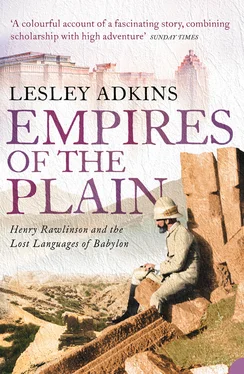The amount of information that could be expressed by this sort of writing was severely limited – most proto-cuneiform tablets were concerned with book-keeping, although about 15 per cent of the surviving tablets are lists of words, such as the names of animals and cities, and were probably used in the training of scribes. As each pictograph or ideogram represented an entire word that could be understood universally, like those used today at airports, the language spoken by the people who made the pictographs is uncertain, but was probably Sumerian. In south-west Iran, once known as Elam, a script composed of numerical and other signs has been found on similarly early clay tablets dating to 3100–2700 BC. It seems to be more developed than simple picture signs, but remains poorly understood. It was originally labelled proto-Elamite on the assumption that it was an early form of the Elamite language that was written down a few hundred years later.
The next development was to write words using the sounds of syllables, a more sophisticated method that enables specific languages to be identified. The earliest language to have been written on clay tablets and the earliest known language in the world is Sumerian, dating from at least 2800 BC – or several centuries earlier if proto-cuneiform is accepted as Sumerian, and so earlier than Egyptian. Sumer was the southern part of Babylonia in the period 3000–2300 BC, and stretched from Nippur (south of Babylon) to the Persian Gulf. The Sumerians called their territory kiengir (‘homeland’), but later their Akkadian neighbours called it Shumeru , from which the modern name Sumer is derived. Sumerian is not related to any known family of languages, and it was possibly the only one of its family to have been written down, with the others dying out before writing was invented. Nothing is known about languages before Sumerian.
By 2600 BC major changes had taken place with the signs used to write Sumerian. They were now written as if turned 90 degrees to the left, so that the outline of a head of an ox was turned on its side and the two horizontal wavy lines representing water became vertical lines. They were also now written from left to right, not right to left. The other major change was that signs were no longer incised in the clay, but were impressed using a reed stylus with an angular end, forming the distinctive cuneiform (‘wedge-shaped’) signs. This was a more rapid way of writing, with the stylus being pushed into the damp clay rather than used to incise lines. Because of this change, signs became much more stylized, so that the sign for an ox was composed of a few impressed lines, barely resembling the original abstract outline of the head of the ox.
These cuneiform signs could still be used as pictographs, so that the stylized sign for a mouth meant ‘mouth’ (ka in Sumerian), and they could still be used as ideograms, so that the sign for a mouth also meant ‘tooth’ or ‘word’ (zú and inim in Sumerian). Many Sumerian words had only one syllable, such as ud , ‘day’, and sometimes even a single vowel, such as a , ‘water’. The signs for these words began to be used phonetically to spell out syllables of different words, regardless of the original meaning of the sign, such as the sign for barley, pronounced she , being used where the syllable she was required. In English an example would be a picture of a ring used to spell the ‘ring’ sound values of ‘bring’, ‘ringleader’ and ‘daring’. As words could now be spelled with syllables, there was no longer a need to have a separate sign for every Sumerian word, and so the number of signs dropped to around six hundred. This was still a very complicated system when compared with modern alphabets of around twenty-five or twenty-six letters, and so knowledge of writing was restricted to specially trained scribes, with the rest of the population remaining illiterate.
On the early Sumerian tablets, the cuneiform signs were grouped randomly in boxes, which were arranged in horizontal rows that were read from the top of the tablet to the bottom, but each box was now read from left to right, not right to left. With the increased use of signs for syllables, the written language became more structured, and grammatical elements developed. More complex words could be expressed, and because word order became important, signs began to be written in a single horizontal line, from left to right. Even so, there was no punctuation, nor any spaces between words.
Because Sumerian cuneiform signs started off as pictographs that were subsequently used as ideograms and syllables as well, almost every sign acquired several different functions. Many signs (termed polyphones) had several alternative sounds. For example, the sign is du , meaning ‘leg’, but the same sign can have other associated meanings with different pronunciations, such as gub , ‘to stand’, gin , ‘to go’, and túm , ‘to bring’. To get around this problem, the correct reading could be emphasized by adding another cuneiform sign, called a phonetic complement, comprising the final consonant and a vowel (usually a). This sign was not pronounced, but indicated what word was meant. For example, when this particular sign was to be read as gin , a sign for na was added, which cuneiform scholars write as gin(na) or gin na.
Several Sumerian signs were pronounced the same way (like flour and flower in English). These signs are termed homophones – having the same sound. For example, there were ten different signs for the word or syllable pronounced tum. In modern transcriptions the particular word meant is shown by the addition of accents and numbers (diacritic signs). For example, several different signs were pronounced gu. The one meaning ‘ox’ is written in transcriptions as gu 4. Scribes also added signs called determinatives (or classifying signs) before or sometimes after a word to indicate the category to which a word belonged, so that its meaning was clarified. The sign ki , for example, indicated that the adjacent word was a place-name and dingir the name of a god. These determinative signs were not pronounced, but were present merely to show the meaning of the words.
Sumerian ceased to be an everyday spoken language by about 2000 BC, but scribes continued to copy out texts and word lists, often with Akkadian translations, because Sumerian became a prestigious and scholarly dead language, like Latin in the Middle Ages. Akkadian, the oldest known Semitic language, belonging to the same family of languages as Hebrew and Arabic, had become the everyday spoken language. The term Semitic was coined in the eighteenth century because the speakers of these languages were believed to be descendants of Noah’s son Shem or Sem. Originally used alongside Sumerian, Akkadian was first written down from around 2500 BC. Although a Semitic language, the cuneiform writing system for Akkadian was based on Sumerian, despite the two languages being vastly different. Early cuneiform decipherment did not tackle Sumerian, as its existence was not initially recognized. Akkadian (‘the tongue of Akkad’, lishanum akkaditum ) takes its name from Akkad (or Agade), which was founded as the capital city of the new empire of Akkad around 2300 BC by King Sargon, after he united several independent city-states in northern Babylonia and Sumer. The city of Akkad has not yet been discovered, but it probably lay north of Babylon.
Most Akkadian words had more than one syllable, and the cuneiform signs used to spell out words phonetically were either single vowels such as a , consonant-vowels such as tu , vowel-consonants such as an or consonant-vowel-consonants such as nim – never single consonants. Sumerian signs were frequently adopted as syllables or to represent entire Akkadian words. For example, the Sumerian sign an , meant ‘sky’ or ‘heaven’, and this same sign was adopted for Akkadian, but in that language was pronounced as shamu. The same Sumerian sign could mean a god, dingir , which was also adopted in Akkadian, but pronounced ilu. Signs taken from Sumerian are now called Sumerograms. Cuneiform scholars today write Sumerian words in lower-case Roman script, Akkadian words borrowed from Sumerian in UPPER-CASE Roman script and Akkadian words in italics in an attempt to lessen the confusion.
Читать дальше












